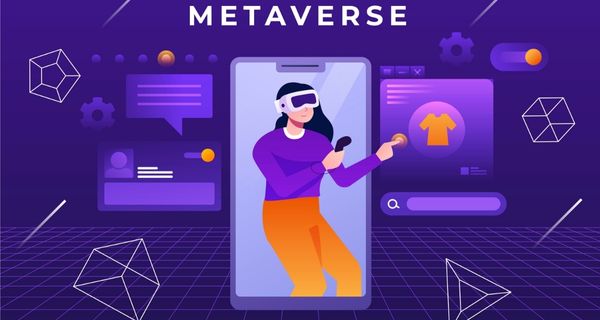Have you ever imagined a world where you can sit comfortably on your couch and dive into a virtual universe that transports you to a realm beyond reality? Well, that’s precisely what the Metaverse is about – a technological advancement combining augmented and virtual reality to create a fully immersive user experience. The possibilities are endless, and with the rapid rise of developments in NFTs, cryptocurrencies, 3D avatars, and immersive gaming experiences, creating a Metaverse app is quickly becoming the next frontier for businesses and industries looking to bring their services and products into the virtual world.
From fashion to real estate, the Metaverse offers boundless opportunities for companies to showcase their offerings and engage with consumers in new ways. It is not just a platform but a new dimension of human interaction, an entirely new reality where people can connect, explore, and create without physical boundaries.
What is Metaverse precisely?
Have you ever imagined a world where the boundaries between reality and the virtual realm blur? That’s precisely what the Metaverse is about – a digital universe where people can interact, socialize and collaborate through 3D virtual worlds powered by augmented and virtual reality technology. It is more than just a virtual space; it’s a platform that transcends physical limitations and connects people from all corners of the globe, creating a new dimension of human interaction.
One of the most exciting aspects of the Metaverse is its potential to revolutionize how we think about the economy. By harnessing the power of blockchain technology and digital currencies, it has the potential to become an autonomous virtual economy where people can trade goods and services seamlessly across borders.
With the advent of non-fungible tokens (NFTs), and unique digital assets stored on the blockchain, the possibilities for trade and commerce in the Metaverse are endless.
From virtual real estate to digital art galleries, it offers a wide range of opportunities for entrepreneurs and businesses to create innovative products and services that cater to the needs and desires of its inhabitants.
The future looks bright, and with the integration of Web3 technology, we can only expect to see more exciting developments in the years to come. So, fasten your seatbelts and embark on a journey where the only limitation is our imagination.
Further, owing to year-long advancements, today creating a metaverse app is more feasible than ever before.
In this blog post, we will explore everything about Metaverse and the current state of Metaverse app development.
What is a Metaverse App?
It is an application that allows users to interact with a virtual world – a collaborative space where users can socialize. In essence, it is a portal that allows users to enter and engage in a virtual world.
Creating a metaverse app primarily begins with designing a three-dimensional environment with digital objects. In addition, it typically features avatar creation tools, allowing users to create a virtual representation of themselves that they can use to navigate and interact with the environment.
How to create a metaverse app?

Developing an app can be utterly simple with modern-day no-code platforms. With the PlugXR creator platform, you can design, develop and publish a Metaverse application with easy drag-and-drop.
With the traditional approach, the development requires a team of skilled developers with 3D modeling, game development, and network programming expertise. The steps include:
1. Conceptualization and Design:
The first step is conceptualizing the idea and creating a design plan.
2. 3D Modeling:
Once the concept and design are finalized, the next step is to make the 3D models for the virtual environment. This includes creating digital assets such as buildings, landscapes, and other objects populating the Metaverse.
3. Game Development:
After the 3D models are built, the developers will begin coding the game mechanics and implementing the rules for the virtual world. This includes creating physics engines, collision detection, and other systems allowing users to interact with the environment and each other.
4. Network Programming:
Network programming is necessary to enable real-time interaction between users in the Metaverse. This includes developing the server infrastructure and protocols allowing users to connect and communicate with each other.
5. Testing and Deployment:
After development, the app must undergo rigorous testing to identify and fix any bugs or issues. Once the app is deemed stable, it can be deployed to the app stores and made available to the public.
Technologies That Power Metaverse Apps
Creating a metaverse app is no easy feat, as it involves multiple technologies that work together to provide a fully immersive experience in the virtual space. Following technologies form the backbone of creating metaverse apps:
1. Blockchain for Metaverse Development:
The Metaverse is closely intertwined with the blockchain, which provides an advanced level of security on the platform. Decentralization principles correspond to the Metaverse’s values, making blockchain development for Metaverse the best way to ensure safe and secure transactions.
2. Virtual Reality (VR):
VR technologies can transport users to almost any location, making it possible to have business meetings or space trips with friends. It makes VR an essential component.
3. Augmented Reality (AR):
Augmented Reality (AR) is another technology that adds interactivity to Metaverse apps. By seamlessly blending digital elements with the real world, AR creates an immersive and interactive experience. You can use AR to navigate unfamiliar surroundings, learn about historical landmarks, or even try on clothes virtually. The possibilities are endless, and AR technology continues to evolve, making it more accessible and user-friendly than ever before. Whether you’re a gamer, a shopper, or a curious explorer, AR offers a new dimension of digital realism that is sure to impress and inspire.
4. 3D Reconstruction:
Creating a digital twin of real-world environments and objects requires recreating them in 3D. It gives the metaverse a real look and feels, indistinguishable from real-world environments and objects.
5. Artificial Intelligence (AI) for Efficient Data Processing:
Artificial intelligence can process a large amount of data quickly, making it useful for the Metaverse, which generates vast data. Also, it creates realistic 3D avatars that resemble human looks, act, and behave appropriately.
6. Internet of Things (IoT) for Accurate Digital Twins:
The use of IoT is fairly simple. It leverages real-world data to replicate the same in the Metaverse world, thus creating accurate replicas of objects.
Features that make Metaverse app development worthwhile
There are a few amazing factors that make metaverse apps appealing. Today, metaverse app development is more attractive than ever owing to the following features:
Technological infrastructure
The technology requirements of a metaverse align with the technological development worldwide, to count some – Internet, Wifi, 5G, AI, blockchain, etc. And as the ideas of the best in the metaverse develop over time, these supportive technologies are also likely to expand their capabilities.
Digital avatars
You must have seen or used digital avatars for virtual “try-on” on an E-commerce site or a retail fashion store. Similar or better digital avatars have become essential to a metaverse application. The digital avatar in a simulated environment walks, talks, and interacts with objects in the metaverse on your behalf.
Human interface technology
So, what is it that connects us, real humans, with the metaverse? Well, it is the human interface technology, AR & VR. Thus, they become a crucial feature of the Metaverse app.
Decentralization
In a metaverse application that you own is not central to an institution. You will stand a chance to have complete ownership of every digital asset that you own. The idea of NFTs and Crypto, thus, are important features.
Persistence
Unlike VR experiences, metaverse functions even when you are not accessing it. This persistence is a major differentiator between the two.
Trading of digital assets
This feature has attracted a lot of attention from people worldwide to become a part of the metaverse world, where you can buy and sell digital assets.
Cost and Time-Efficient Metaverse App Development
The cost of developing a metaverse app can be a significant barrier for many businesses and individuals interested in exploring the potential of virtual reality. Hiring a development team and investing in advanced programming skills can quickly add to a substantial expense.
With PlugXR’s no-code cloud-based platform you can significantly reduce the cost and time investment. By eliminating the need for advanced programming skills and offering a range of pre-built features and templates, PlugXR allows users to create immersive Metaverse apps without needing a dedicated development team, slashing time and cost investment by 1/10th,
Metaverse App Android

While metaverse apps are still in their early stages of development, several options are already available for Android users. Some popular ones for Android include Second Life, VRChat, and Sansar.
To create a metaverse app for Android, developers must follow the steps outlined above. In addition, however, they must also ensure that their app is optimized for mobile devices, with a user interface that is easy to navigate on a small screen. This may involve creating custom controls or designing the app to work with virtual reality headsets.
Metaverse app iOS
With the increasing popularity of metaverse apps, it’s no surprise that developers are also exploring the possibilities of creating one for iOS devices. While there are currently fewer options available for iOS users compared to Android users, several Metaverse apps can still be enjoyed on Apple devices. For example, High Fidelity is an app compatible with iOS devices, allowing users to create and customize their avatars, explore virtual worlds, and interact with other users.
Similarly, AltspaceVR can be accessed on iOS devices, allowing users to attend virtual events, play games, and engage in social activities with other users. Of course, as with any app, developing a version for iOS requires a dedicated team of developers with expertise in 3D modeling, game development, and network programming, but the potential for creating a truly immersive and engaging virtual world on iOS devices is just as exciting as it is on Android devices.
Metaverse apps have the potential to revolutionize the way we interact with each other and digital content, offering a new realm of possibilities for gaming, socializing, and entertainment.
Oculus Metaverse App is another example of a metaverse world created by Facebook’s parent company Meta. It allows its users to gather and interact with others in an avatar form.
Key takeaways
Metaverse apps have the potential to revolutionize the way we interact with each other and digital content, offering a new realm of possibilities for gaming, socializing, and entertainment. While its development is a complex process, with the right team of developers and a clear plan, creating a virtual world that will captivate and engage users for years to come is possible.

